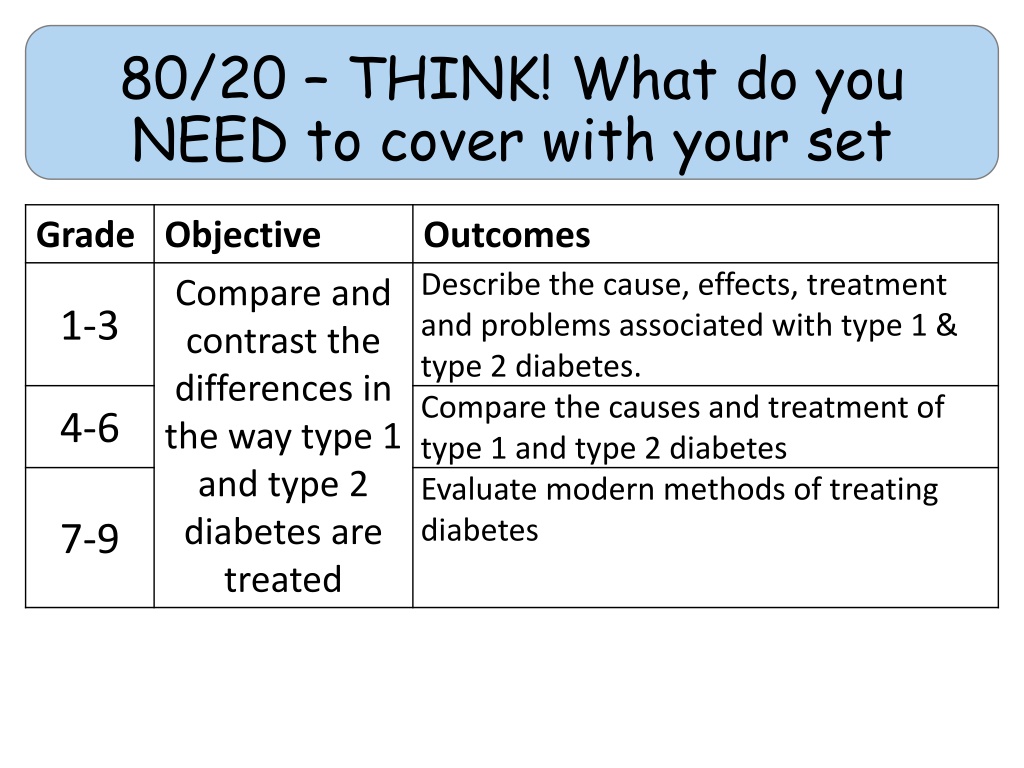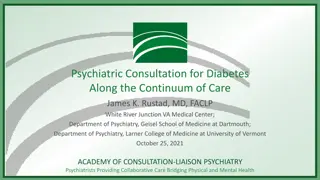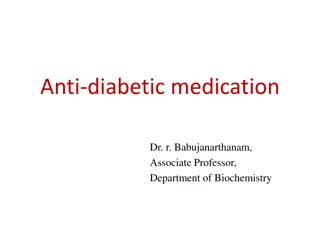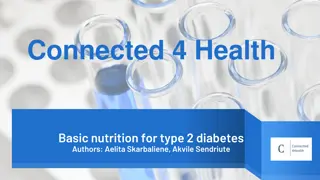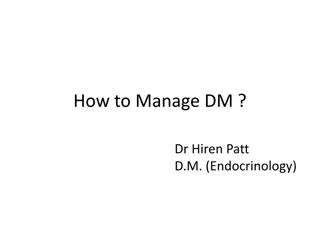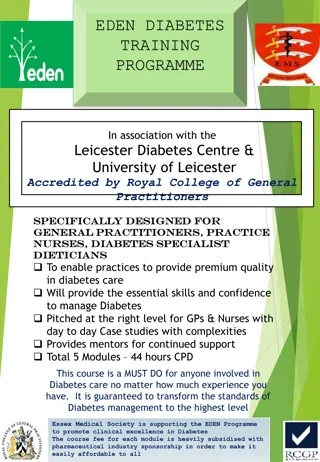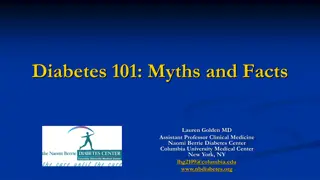Understanding Diabetes: Type 1 vs. Type 2, Causes, Treatments, and Modern Methods
Explore the differences between type 1 and type 2 diabetes, including causes, effects, treatments, and associated problems. Compare the causes and treatments of both types of diabetes while evaluating modern methods of treatment. Understand the symptoms, lifestyle factors, and risk factors related to diabetes, and learn how advancements in treatment have improved the management of the condition.
Download Presentation

Please find below an Image/Link to download the presentation.
The content on the website is provided AS IS for your information and personal use only. It may not be sold, licensed, or shared on other websites without obtaining consent from the author. Download presentation by click this link. If you encounter any issues during the download, it is possible that the publisher has removed the file from their server.
E N D
Presentation Transcript
80/20 THINK! What do you NEED to cover with your set Grade Objective Compare and contrast the differences in the way type 1 and type 2 diabetes are 7-9 Outcomes Describe the cause, effects, treatment and problems associated with type 1 & type 2 diabetes. Compare the causes and treatment of type 1 and type 2 diabetes Evaluate modern methods of treating diabetes 1-3 4-6 treated
Treating Diabetes Do now activity: 1. What are some of the main symptoms of diabetes? 2. Describe the causes of type 1 and type 2 diabetes 3. Do you know of any treatments which may be used by people that have type 1 or type 2 diabetes?
Progress indicators GOOD PROGRESS: Describe the cause, effects, treatment and problems associated with type 1 & type 2 diabetes. Compare the causes and treatment of type 1 and type 2 diabetes OUTSTANDING PROGRESS: Evaluate modern methods of treating diabetes
Quick Recap: Key Words: blood, overweight, diet, diabetes, insulin, healthy People with ____________have high _______ sugar levels because some of their cells don t respond to the hormone________. You are much more likely to develop diabetes if you have family members with it or if you are ______________. A _________ lifestyle, with plenty of exercise and a balanced _________, reduces the risk of diabetes.
Self-assessment: diabetes blood People with ____________have high _______ sugar levels because some of their cells don t respond to the hormone________. You are much more likely to develop diabetes if you have family members with it or if you are ______________. A _________ lifestyle, with plenty of exercise and a balanced _________, reduces the risk of diabetes. insulin overweight healthy diet
Before there was any treatment for diabetes, people would waste away. Eventually they could fall into a coma an die. The treatment for this condition has developed over the years and continues to improve today. There are now some very effective ways to monitor and treat diabetes. However, if not managed properly this can still cause problems with the circulatory system, kidneys or eyesight.
Task: On your table you are going to be given some information about type 1 and type 2 diabetes. Using this information, answer the following questions: 1. State three differences between type 1 and type 2 diabetes (3 marks) 2. It is a common misconception that diabetes is treated only by using insulin injections. a) Explain why this it not always true for people with type 1 diabetes (3 marks) b) Explain why treatment with insulin injections is relatively uncommon for people with type 2 diabetes. (3 marks)
Self-assessment: 1. Three differences between type 1 and type 2 diabetes include: Type 1 diabetes is where your pancreatic cells no longer produce insulin whereas in type 2 diabetes your pancreas can still make insulin but there may not be enough of it or it is ineffective The development of type 2 diabetes is linked to poor diet, lack of exercise and old age, whereas type 1 diabetes is not. Treatment of type 1 diabetes is controlled mainly by taking regular insulin injections whereas type 2 diabetes can be controlled by controlling diet, exercising and losing weight.
2. It is a common misconception that diabetes is treated only by using insulin injections. a) If you have type 1 diabetes you will use insulin injections but you also need to be careful about the level of carbohydrates that you consume. You should eat regular meals and exercise regularly to keep your heart and blood vessels healthy. However, you will need to plan your exercise according to your meals so that you glucose levels stay steady. Your cells need enough glucose to respire more rapidly to produce the energy required for your muscles to work. b) Insulin injections are relatively uncommon for people with type 2 diabetes as is often the case that their cells will no longer respond to insulin anyway. In order to control and combat the effects of type 2 diabetes patients are advised to exercise regularly, eat a balanced diet and try to lose weight. If this doesn t work patient can be prescribed a range of medicines to aid the control of their blood glucose levels.
Curing type 1 diabetes Scientists and doctors want to find a treatment that means people with diabetes never have to take insulin again. Task: In pairs, read through the cards of information on medical advances in curing diabetes. Create a table to sum up the advantages and disadvantages for each of these treatments. Extra Challenge Question: Compare the treatment of pancreas transplants with insulin injections and explain why pancreas transplants is not more widely used. (4 marks)
Self-assessment: Treatment Advantages Disadvantages Whole pancreas transplants -Doctors can transplant a pancreas successfully -Patient no longer needs to inject insulin -Operations are difficult and risky -Not enough donors are available -Patients must take immunosuppressant's for the rest of their life to prevent rejection Pancreatic cell transplants -Both dead and living donors can be used -Only cells required , not whole organs -This has had limited success so far Genetically engineering faulty pancreatic cells -The hope is that one day scientists will be able to genetically engineer patients OWN faulty pancreatic cells so that they work properly to release insulin -They can then be returned to the patient without any rejection issues -Using stem cells for medical purposes such as this is not ethically acceptable to some people -Much more research is needed
Exam Question 1. Homeostasis controls the internal environment of your body. a) Explain how blood glucose levels are controlled in someone who does not have diabetes (4) b) Compare how each type of diabetes is causes and suggest how each type of diabetes could be treated (4) Shhh Silent work! 8 minutes = 8 marks
Self-assessment: a) If blood glucose levels are too high insulin is released from the pancreas Glucose is moved into body cells If blood glucose levels are too low, glucagon is released from the pancreas This causes glycogen to be converted into glucose and released into the blood b) In Type 1 diabetes not enough insulin is produced This can be treated with insulin injections In Type 2 diabetes the cells do not respond to insulin Type 2 diabetes is treated with diet & exercise / loss or weight / medical treatment
Plenary: Anagram Challenge: 1. jenictonsi 2. bedaiset 3. nacarpes 4. tochredyarba 5. nuiisln 6. lsocgue glucose injections diabetes pancreas carbohydrate insulin Unscramble the words to find 6 key words related to the lesson today!
Resources Resources
Treating type 1 diabetes If you have type 1 diabetes, you need replacement insulin before meals. Insulin is a protein that would be digested in your stomach, so it is usually given as an injection to get straight into your blood. This injected insulin allows glucose to be taken into your body cells an converted into glycogen in the liver. This stops the concentration of glucose in your blood from getting too high. Then, as the blood glucose levels fall, the glycogen is converted back to glucose. As a result your blood glucose levels are kept stable. If you have type 1 diabetes you also need to be careful about the level of carbohydrates that you consume. You should eat regular meals and exercise regularly to keep your heart and blood vessels healthy. However, you will need to plan your exercise according to your meals so that you glucose levels stay steady. Your cells need enough glucose to respire more rapidly to produce the energy required for your muscles to work. Insulin injections treat diabetes successfully but they do not cur it. Until a cure is developed someone with type 1 diabetes will have to inject insulin every day of their life.
Treating type 2 diabetes Type 2 diabetes is linked to obesity, lack of exercise and old age. If you develop the disease your body cells no longer to respond to any insulin made by the pancreas. This can often be treated without needing to inject insulin. Many people can often be treated without needing to inject insulin, Many people can restore their normal blood glucose balance by following these steps: Eat a balanced a diet with carefully controlled amounts of carbohydrates Lose weight Make sure you exercise regularly If this doesn t work there are drugs that will: Help insulin work better on the body cells Help your pancreas to make more insulin Reduce the amount of glucose that you absorb from the gut If none of these treatments work then you will probably need insulin injections. Type 2 diabetes usually effects older people but it is become more common in young people who are overweight.
Doctors can transplant a pancreas successfully. However the operations are difficult and risky. Only a few hundred pancreas transplants take place each year in the UK. There are 250,000 people in the UK with type 1 diabetes and not enough donors are available. Plus, even if a patient has a transplant they will still need to take medication, instead of insulin they will take immunosuppressant's for the rest of their life. Scientists have also started to try and transplant the pancreatic cells that make insulin from both dead and living donors. However this has had limited success so far. In 2005, scientists produces insulin-secreting cells from embryonic stem cells and used them to cure diabetes in mice. In 2008 a completely new technique was found - genetically engineering mouse pancreas cells into insulin-producing cells. The hope is that one day scientists will be able to genetically engineer faulty pancreatic cells so that they work properly to release insulin, they can then be returned to the patient without any rejection issues. However, using stem cells for medical purposes such as this is not ethically acceptable to some people and much more research is needed.
